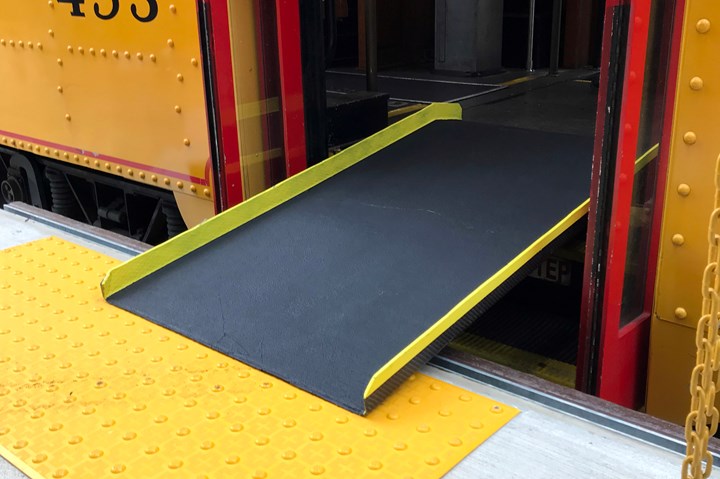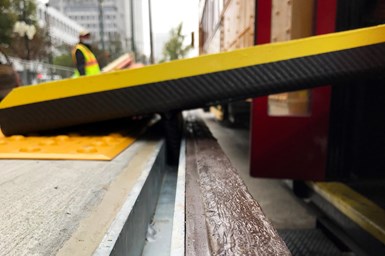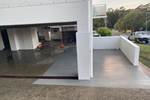Memphis Area Transit Authority implements CFRP service ramps
CFRP ramps for rail trolley cars are 60% lighter and three times stronger than metal, promote employee and public safety when onloading and offloading and are ADA-compliant.

Rail trolley composite service ramp. All photo credit: MATA via WSP USA
It was reported on Dec. 3 that the Memphis Area Transit Authority (MATA, Memphis, Tenn., U.S.) is immediately deploying new service ramps on its rail trolley cars that are made carbon fiber-reinforced polymer (CFRP), traditionally used to reinforce concrete buildings and bridges. More than 60% lighter and three times stronger than metal ramps, the new infrastructure bridge the gap between the rail trolley and station boarding platform area, and are easily to life and put into place by trolley operators at specific stops.
“The use of carbon fiber instead of glass fiber will provide the rail trolley ramps even more strength and durability over other standard materials while remaining a lighter weight solution as compared to traditional metal service ramps,” says Fran Sosa, supervising bridge engineer for Nashville-based WSP USA, the consulting engineers on the project.
Easy to handle when the rail trolleys stop to board customers, the ramps not only promote both employee and public safety, but represent a safer way to load and offload. The ramps are also compliant with the Americans with Disabilities Act (ADA) and allow for safer, more secure loading of wheelchairs, walkers and other assistance devices.
“This is another application of CFRP that benefits the public,” says Mo Ehsani, president and CEO of QuakeWrap Inc. (Tuscon, Ariz., U.S.) and Centennial Professor Emeritus of civil engineering at the University of Arizona. “The weight of these ramps was a primary concern to MATA. Our unique design led to each ramp weighing only 25 pounds, while exceeding the strength and deflection requirements set by the client.”
The first carbon FRP ramp used by MATA is designed specifically for rail Trolley Car 453, a double-truck replica of a Birney, a type of streetcar that was manufactured in the U.S. in the 1910s and 1920s. The original design was small and light, intended as an economical means of providing frequent service at a lower infrastructure and labor cost than conventional streetcars.

Serving as an on-call engineering consultant to the MATA Trolley Division, WSP USA reached out to QuakeWrap, Inc. for the design and fabrication of the CFRP ramps. QuakeWrap is the original company to patent the use of CFRP for structural engineering rehabilitation, and the ramps are made at its 8,000 square-foot manufacturing site in Arizona.
Ehsani says he has spent more than 25 years pioneering the use of CFRP for the reinforcement and strengthening of columns and buildings to prevent their catastrophic failure during earthquakes, which lead to the founding of QuakeWrap in 1994.
Since then, Ehsani and QuakeWrap have become the authority on using FRP for infrastructure repair, including its use on large underground pipelines for storm and sewers, at major commercial ports for concrete piers and commercial seawalls, in mines and other highly corrosive environments and more.
Related Content
-
Otto Aviation launches Phantom 3500 business jet with all-composite airframe from Leonardo
Promising 60% less fuel burn and 90% less emissions using SAF, the super-laminar flow design with windowless fuselage will be built using RTM in Florida facility with certification slated for 2030.
-
Bladder-assisted compression molding derivative produces complex, autoclave-quality automotive parts
HP Composites’ AirPower technology enables high-rate CFRP roof production with 50% energy savings for the Maserati MC20.
-
Filament winding increases access to high-performance composite prostheses
Steptics industrializes production of CFRP prostheses, enabling hundreds of parts/day and 50% lower cost.















